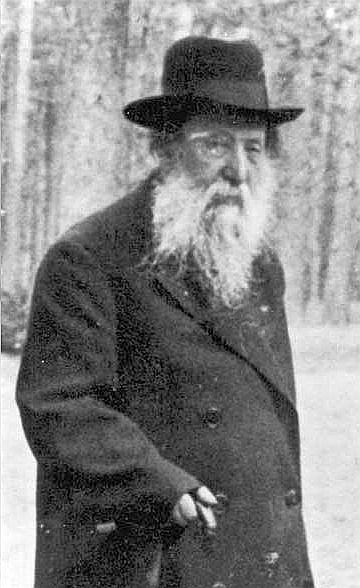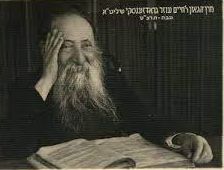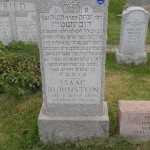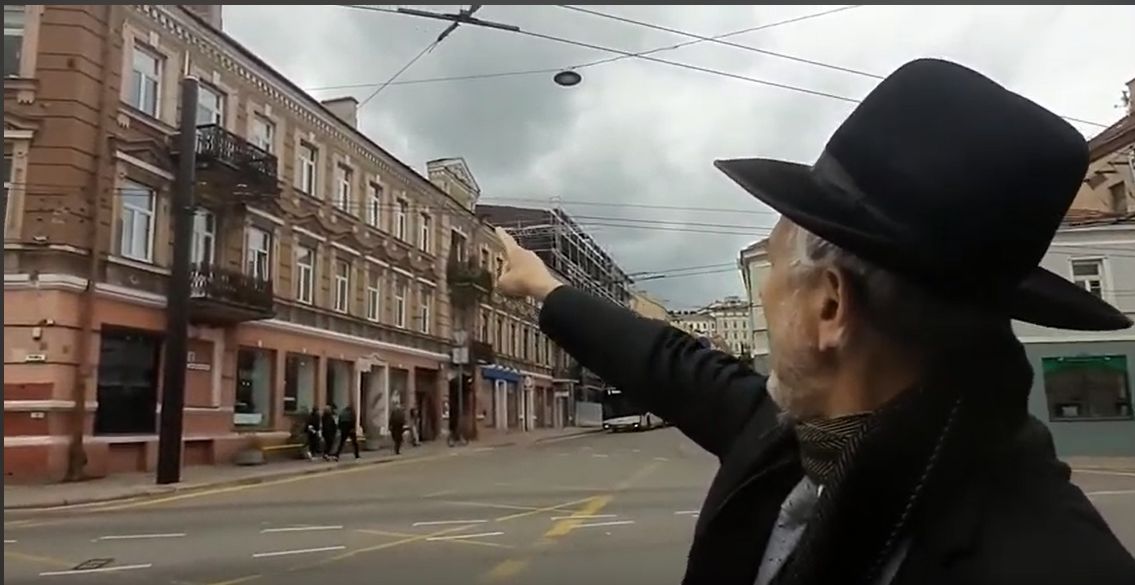| | NEWS
For The Sake Of Kovod HaTorah: The Battle Over The Vilna Rabbinate
By Rabbi Avrohom Meir Wexelstein
HaRav Chaim Ozer

Part V: Conclusion
This series has discussed the background of Vilna, the Yerushalayim of Lithuania, and its rabbonus over a hundred years ago. We saw that the real position of Chief Rabbi of Vilna was left unfilled for more than a hundred years, out of respect, until the secular authorities insisted on the appointment of a rav to administer the registration of demographic information such as births, deaths and weddings. The community was required to appoint such a "rav meitaam," and the choice came down to a test of strength between the traditional side lead by HaRav Chaim Ozer, and the reformers and maskilim. Before his election, Rabbi Rubinstein, a former yeshiva student, promised Reb Chaim Ozer that he would stay clear of any involvement in Vilna's communal institutions. In return he was backed by Reb Chaim Ozer and elected.
Reb Chaim Ozer's forced absence from Vilna during the First World War enabled Rabbi Rubinstein to greatly increase his sphere of influence in Vilna's communal affairs, in direct violation of the promise he had given Reb Chaim Ozer upon his election. When the Polish government required the Jews to hold new elections in 1919, the chareidim were in a minority against the combined forces of secularists, Zionists and religious Zionists and they were powerless to prevent Rabbi Rubinstein's accession to the seat of the Vilna Rabbinate.
The last chapter chronicled the protest campaign led by the Chofetz Chaim to redress the terrible wrong that had been perpetrated against the honor of Reb Chaim Ozer and of Torah itself. We saw the letters issued by the Chofetz Chaim and the importance attached to the issue by the Chazon Ish. The press became very involved in the controversy.
The Appointment
Part V: Conclusion
This series has discussed the background of Vilna, the Yerushalayim of Lithuania, and its rabbonus over a hundred years ago. We saw that the real position of Chief Rabbi of Vilna was left unfilled for more than a hundred years, out of respect, until the secular authorities insisted on the appointment of a rav to administer the registration of demographic information such as births, deaths and weddings. The community was required to appoint such a "rav meitaam," and the choice came down to a test of strength between the traditional side lead by HaRav Chaim Ozer, and the reformers and maskilim. Before his election, Rabbi Rubinstein, a former yeshiva student, promised Reb Chaim Ozer that he would stay clear of any involvement in Vilna's communal institutions. In return he was backed by Reb Chaim Ozer and elected.
Reb Chaim Ozer's forced absence from Vilna during the First World War enabled Rabbi Rubinstein to greatly increase his sphere of influence in Vilna's communal affairs, in direct violation of the promise he had given Reb Chaim Ozer upon his election. When the Polish government required the Jews to hold new elections in 1919, the chareidim were in a minority against the combined forces of secularists, Zionists and religious Zionists and they were powerless to prevent Rabbi Rubinstein's accession to the seat of the Vilna Rabbinate.
The last chapter chronicled the protest campaign led by the Chofetz Chaim to redress the terrible wrong that had been perpetrated against the honor of Reb Chaim Ozer and of Torah itself. We saw the letters issued by the Chofetz Chaim and the importance attached to the issue by the Chazon Ish. The press became very involved in the controversy.
The Appointment
The Torah-true lay leaders attempted to utilize every means at their disposal and turned to the Polish government to veto Rabbi Rubinstein's appointment. Apparently the gentiles understood what the Mizrachi party failed to understand, for the appointment was almost declared "illegal." In the end however, thanks to a political deal, it was ratified.
Rabbi Rubinstein was the Mizrachi's delegate to the Polish Sejm (Parliament). His party was allied with the party of the infamous Yitzchok Greenbaum, who was in the political opposition at that time. The deal was that Greenbaum promised that he would transfer his allegiance to a different, more moderate Jewish party, if Rabbi Rubinstein's appointment received government approval.
Rabbi Rubinstein's induction ceremony was held in the Beis Knesses Hagodol which was controlled by Vilna's Zionists. Protected by a few tough youngsters, Rabbi Rubinstein was brought to the ceremony and he began his inauguration address. He had just begun when one of the Chazon Ish's talmidim who was present, let out a great and bitter cry of protest against the disgrace of Torah's honor. It was a miracle that he escaped with his life after being attacked by Rabbi Rubinstein's "bodyguards" who beat him up and then ejected him.
Rabbi Avrohom Rein smilingly remembers Rabbi Rubinstein's first Pesach as rabbi, when he delivered a drosho on Shabbos Hagodol in the beis haknesses. It was a very large shul that could seat five thousand and there were two galleries, and it was almost completely full. Rabbi Rein was twelve at the time and came with a few of his friends to create a disturbance. They sang and caused a small commotion..."Of course," Rabbi Rein concluded, "it didn't help a bit..."
The Vaad HaRabbonim called the Communal Council (the body that had elected Rabbi Rubinstein) and the new rabbi to a din Torah. They refused to come. Although the Vaad HaRabbonim was willing to go before any beis din of the defendants' choice, the latter were unwilling to go to any beis din.
There were many compromise suggestions, as there always are. One idea was that a separate community be established in Vilna (led by Reb Chaim Ozer) but this required official permission, which was not forthcoming. Some proposed making Reb Chaim Ozer a deputy, or establishing two rabbinical bodies that would work side-by-side.
Years later the Chazon Ish related that he had presented every one of these ideas to the Chofetz Chaim, who opposed any compromise. The Chofetz Chaim, in a letter dated yom rishon leseder Nosso, shnas 5689 (1929), wrote the following to HaRav Chaim Ozer in this vein:
My honored friend, the great gaon...Moreinu HaRav Chaim Ozer Grodzensky, shlita, gaon, av beis din kehillas Vilna...,
How important it was that I should have visited you! I decided to travel to Vilna today but lo aleinu, I took ill with catarrh and am unable to travel. I will therefore let you know what I think in writing.
It distresses me greatly that some are considering making a compromise in the matter of the Vilna rabbonus. I know the different aspects of the questions involved — all the reasoning and the arguments for all the sides — but in my opinion we must not do this. We should not be the first ones to arrange a state of affairs whereby the rabbonus is divided into two authorities, for [communities in] all other places will see what we are doing and will follow suit. They will say, "But all the gedolei Yisroel agreed to it!"
In retrospect, all our protests will automatically be worthless. They will say that the perushim permitted it and that we are forced to agree to everything that the public demands. When we stand our ground firmly though, and do not permit the honor of the Torah and of the rabbonus to be demeaned, then the whole world will know, as will the government ministers, that it is contrary to Torah and to our religion, and that we have done what we could, and Hashem in His goodness will do what is good.
Know my friend, that when I issued my first protest, I knew very well that I would be the target of accusations and that they would look everywhere for pretexts to persecute me. However, I made up my mind that whatever would be would be, in order that the Torah's honor not be disgraced. I prepared myself for absolutely any outcome, chas vesholom. I will not be silent for the sake of Hashem and His Torah because all those who sacrificed themselves for kiddush Hashem neither had their dignity put to shame, nor their standing lessened. Let the whole world know that Hashem's and the Torah's honor are of greater importance to us than our very lives. It is not for nothing that a mitzvas aseh of sanctifying Hashem's Name with all our soul has been fixed in krias Shema twice each day.
May Hashem, haTov, see our afflictions and fight our quarrels and spread his Sukkah of peace over us. I remain, with this, your friend,
Yisroel Meir Hacohen

The Aftermath
After eighteen months of conflict, day in, day out, things began to quiet down and people slowly returned to their ordinary routines. Rabbi Rubinstein was officially rabbi of Vilna and he controlled all the communal institutions. He removed the community property that had been under the control of the Tzedaka Gedola from that body's jurisdiction. This property included the Beis Haknesses Hagodol and the cemetery, as well as several other houses in the city and altogether they brought in a handsome income.
Reb Chaim Ozer's followers refused to give over the management of the Tzedaka Gedola itself to the Communal Council (the body that had been convened to elect the rabbi) since Bundist delegates were associated with the council. Efforts were made by rabbonim and gedolei Torah to intervene with the Polish authorities in order to prevent the Tzedaka Gedola's transfer to the council. In the end, employing various means, Rabbi Rubinstein did manage to gain exclusive control over the magnificent institution that had led Jewish Vilna for many decades.
The Communal Council again confirmed Rabbi Rubinstein as Vilna's Chief Rabbi. The newspapers reported that "the "Council of the Jewish Community of Vilna" confirmed the choice of Rabbi Rubinstein as Chief Rabbi of Vilna. The resolution was passed by a majority of seventeen to five — the opposition being the Aguda members. Yitzchok Greenbaum sent congratulations to Rabbi Rubinstein on his appointment, in the name of the "Club of Jewish Delegates" — Greenbaum's greetings were no empty gesture.
The same newspaper also reported that the "head of the Aguda," Pinchas Cohen declared, "Vilna's chareidim consider Reb Chaim Ozer Grodzensky as their Chief Rabbi to this day and they will never be reconciled with this appointment."
As far as Vilna's Torah faithful were concerned, Reb Chaim Ozer remained the rabbi. Rabbi Rubinstein's "official" election, achieved with the votes of public Shabbos desecraters and belittlers of Torah, did not mean anything to them. Vilna — the Gra's Vilna — the Vilna of the Torah world and of the yeshivos, the city of Torah and chesed, remained faithful to Reb Chaim Ozer even though his honor had been trampled by unworthy men.
In New York's Yiddish Morgen-Journal, the editor, Peretz Vernick, who was a native of Vilna, wrote in an emotional editorial, "To the world, it makes no difference whether Vilna elects Reb Chaim Ozer as its Chief Rabbi or not. For the world, Reb Chaim Ozer was and remains a godol and the generation's leader."
Indeed, the captain of the Jewish boat remained at the wheel, navigating his vessel between the churning waves of apostasy up until his death at the end of 5700 (1940). The battle of Vilna, which had a detrimental effect on his health, had brought about no real changes.
The only possible exception was the permission the government granted Reb Chaim Ozer in 5692 (1932) to use the title "Rav of Vilna" as well as Rabbi Rubinstein. This was the title that had been offered to him twenty-five years earlier in 5667 (1907). Then, he had refused it. Two and a half decades later he remarked, "If I would have seen what would develop, I would have accepted the office. A man however, is only a man and not an angel."
Rabbi Rubinstein's gravestone in the US

Drawing Conclusions
If little changed in Vilna as a result of the controversy, the effects were definitely felt and noted elsewhere. One outcome was that the Zionists did not try to take over the rabbinate in any other community. They preferred to do without a repeat of the Vilna campaign which had the backing and the encouragement of the Chofetz Chaim.
Another result was the revelation of the true nature of the Mizrachi leaders like Rabbi Rubinstein. The chareidi world understood very well the purity of the motives of the man who served as a member of the Sejm and the Polish Senate for the Mizrachi, as a member of the Jewish Agency, a member of the board of governors of the Hebrew University, president of the Polish Council of Keren Hayesod, president of the Federation of Mizrachi in Poland, chairman of the "Yavneh" Federation for religious education, Mizrachi delegate to the Zionist Congresses, member of the executive of the Jewish Congress and more — the man who in addition — woe to us for the shame! — served as rabbi of Vilna.
The wayward path taken by Mizrachi — the movement described by the Chofetz Chaim's talmid, HaRav Elchonon Wassermann as a one way bridge, which is crossed only in the direction of departure from religion but not in returning — had been illuminated in its true light. Anyone could now see the difference between the Aguda and Mizrachi.
Several men of stature left the National-Religious movement as a result of their disappointment in the tactics that had been used by Rabbi Rubinstein and his supporters and the subsequent chilul Hashem and shaming of the Torah.
Even though the Mizrachi movement was in its infancy, Reb Elchonon, with his crystal clear vision, foresaw the movement's later development. He summed up its ideology in a few words as, "Avoda zara beshituf" — idol worship in partnership, i.e. allegiance to Torah as well as something else opposed to Torah.
Even many who initially identified with the National-Religious ideology, left the movement that had shamed the gaon hador. One of those, Rabbi Avrohom Yaakov Hacohen, announced on the pages of Dos Vort that, "I already have nothing to do with the Mizrachi Federation of Vilna. To my chagrin, today's Mizrachi have gone off the path — its actions cause damage to chareidi Jewry."
Several years later there were still Torah Jews for whom the National-Religious movement was a "sacred cow." Ultimately though, all came to recognize the true aims of the Mizrachi and the spiritual abyss to which it led.
Today, Mizrachi's deterioration is clearly visible. Every Jew who is a yirei Shomayim understands that the movement which made "compromise" its guiding principle, has dramatically regressed. Its unworthy attitude, which it claims is "the way of Beis Hillel," has proven itself as a way that is capable of compromising everything with the possible exception of the mitzva of yishuv Eretz Yisroel.
No great insight is necessary today to see Mizrachi for what it is and to reject it. Gedolei Yisroel, with their penetrating vision , saw all this long ago but nobody paid attention. In the meantime, Mizrachi succeeded in ruining many a goodly portion and in penetrating the Rabbinate, taking upon themselves powers that posed a grave danger in their hands and brought on calamity.
HaRav Elchonon Baron pointing out Reb Chaim Ozer's home

Eye Of The Storm?
One more point has to be considered. How was the little house on the corner of Zavlana Street, where Reb Chaim Ozer lived, positioned in the battle against the usurpers and shamers of the Torah? What role was played by the godol hador who had a hand in every other campaign that was waged on behalf of Torah Jewry?
Surprising as it may sound, Reb Chaim Ozer took absolutely no part in this controversy, neither active nor passive. He was simply unable to. The struggle was undertaken partly, perhaps mainly, to salvage his honor. This held him back from any kind of leadership or involvement.
Furthermore, he was even pained by the fact that the Chofetz Chaim and the other gedolei Torah who followed him, were fighting for his honor. There were certainly ample grounds for protest in the assault on the seat of the Vilna Rabbinate and the precedent that had been created for Zionist takeover of the communal institutions.
He found it hard to understand why another factor — his own honor — had to be introduced. Why had the Chofetz Chaim — on addressing the meeting of the heads of Vaad Hayeshivos and asking them to issue a public protest, upon which he had received the reply that such a protest could damage the yeshivos' income — found it necessary to remark, "Let all the yeshivos close down as long as Reb Chaim Ozer's honor is not lessened"?
This is the reason why Reb Chaim Ozer tried to remain away from the action, contenting himself with the reports he received of the state of affairs. It would be quite wrong to assume though, that he was not personally affected by the entire episode.
Rabbi Avrohom Rein of Petach Tikva relates that on one occasion an Aguda convention was held in Vilna. Reb Chaim Ozer was on the dais and he requested that no mention be made of the issue that was uppermost in everybody's mind. Rav Alexander Zushe Friedman, author of Ma'ayana Shel Torah and an Aguda leader in Poland was, however, unable to hold back and he mentioned what was then going on in Vilna.
Reb Chaim Ozer stood up, silenced him, and in a choking voice begged, "I am a broken man...my only daughter passed away...I beg you to stop...I have no wish that it be spoken of..."
A similar story is told by Rabbi Binyamin Zeev Jacobson who was invited around that time to address an Aguda meeting in Vilna. He had travelled specially to Vilna, together with Rabbi Tuvia Horowitz Hy'd, and the two were hastily invited to Reb Chaim Ozer's house.
"I am not interested in your speaking, unless you promise me that you will not speak on the subject of the elections for the Vilna Rabbinate," the gaon told them. Rabbi Jacobson gave his word but when he delivered his speech, he included a sentence to the following effect:
"Everybody knows what is troubling us but what can I do, after our teacher shlita has forbidden me to speak of it?"
On returning to Reb Chaim Ozer after the meeting, Rabbi Jacobson discovered that he was aware of the oblique reference he had made. Reb Chaim Ozer protested: "If I forbid you then my prohibition covers everything — including hints! Don't you understand? If Hashem yisborach has not found me fit to bring up my only daughter, I am certainly not worthy to sit on the seat of the Vilna Rabbinate."
"And tears poured from the eyes of the elderly tzaddik," concludes Rabbi Jacobson. From these recollections, it is obvious that Reb Chaim Ozer was very deeply affected by the episode. Almost incredible strength of character enabled him to maintain his low profile, not indifference.
Not only did Reb Chaim Ozer refrain from any involvement in the controversy, he even maintained friendly relations with Rabbi Rubinstein. a reliable source related to Rabbi Y. Z. Diskin of Pardes Channah of once accompanying Reb Chaim Ozer on his daily walk. When they reached Rabbi Rubinstein's house, Reb Chaim Ozer took his leave and went inside to visit his friend.
Rabbi Avrohom Rein also remembers a similar story. "Once," he recalls, "I was spending some time in Reb Chaim Ozer's house when there was a sudden knock. I opened the door a crack and the saw the tall, upright figure of Rabbi Rubinstein before me.
"`Is the rav at home?' he asked.
"`Yes,' I nodded.
"He entered, and they sat conversing like old friends. I didn't hear a word of what they said because I left the house. I didn't dare to stay and listen."
It was as though a Bas Kol was calling, proclaiming Reb Chaim Ozer's nobility to the world. As if a heavenly voice was saying: "See what a man exists in creation!" The echoes of this voice may have reached right around the world but they seem to have passed over the ears of Rabbi Rubinstein, whose house was in the street next to Reb Chaim Ozer's.
Until, that is, the bitter day when Reb Chaim Ozer was recalled to the heavenly academy. Rabbi Rubinstein suddenly realized just who he had been quarreling with, just whose feet he had tried to push aside.
He hurried over to the small house on Zavlana Street that was surrounded by crowds of mourners. At that time, almost a year into the Second World War, Reb Chaim Ozer had been involved in efforts on behalf of the thousands of refugees who had escaped from their hometowns and flocked to Vilna seeking refuge. The loss was therefore felt even more keenly.
Rabbi Rubinstein was admitted and sat prostrate, next to the body on the floor, recalls Rabbi Shmuel Rothstein, a biographer of Reb Chaim Ozer. He sat and wept bitterly. Then he asked forgiveness from his "rival," the gaon hador.
While Rabbi Rubinstein escaped Europe at the beginning of the war, he did not long outlive Reb Chaim Ozer even though he was by far the younger of the two. The following notes are taken from the book, Refugee And Survivor, by Dr. Zerach Warhaftig, a former Minister of Religion in Israel, published by Yad Vashem:
"Upon my arrival at Yokohama from Kobe, I found a cable informing me of the impending arrival of Rabbi Isaac Rubinstein at Tsuruga... Rabbi Rubinstein, who stayed in Japan but a short while on his way to the U.S., symbolized to me the predicament of the refugee... As a refugee he felt uprooted, his glory spent. He never really adjusted to his new surroundings. All during his stay in Japan he was depressed about the daughter he had left behind in Vilna. In New York he taught at Yeshiva University and published his memoirs from World War I in the Yiddish press. But he was never the same. The tall, proud man had been humbled. He was a refugee. He did not live long after that. In 1945 he died in New York.
Postscript
An interesting story which took place during this time is mentioned in Pe'er Hador, the biography of the Chazon Ish. It was related by HaRav Shraga Feivel Steinberg zt'l, rosh yeshivas Tiferes Tsion.
While the Rabbinate controversy raged, HaRav Moshe Karelitz, the brother of the Chazon Ish, brought to press one of the issues of the Torah journal Knesses Yisroel, which he edited. Some of the Chazon Ish's chidushim were included, under the pseudonym, "Mipi Hashmu'a — From Hearsay." Part of the Chazon Ish's piece concerned something that Reb Chaim Ozer had written in his sefer, Achiezer and these remarks were prefaced with the words, "Our great teacher wrote in Achiezer..."
The Chazon Ish later explained why he had used that term particularly. First, because he wanted to spread Reb Chaim Ozer's fame after the humiliation he had suffered at the hands of Rabbi Rubinstein and his associates. Second, he wanted to increase Reb Chaim Ozer's honor because he was about to refute some of his teachings and third, simply because the title he had bestowed on Reb Chaim Ozer was the truth.
In the next issue, which appeared in MarCheshvan 5691, Reb Chaim Ozer wrote a lengthy teshuva in reply to the points raised by the anonymous writer. (This teshuva was later published in Achiezer, III:52.) From Reb Chaim Ozer's words, it is clear that he knew the identity of the author of the comments. He wrote, "Praise to the Ish who takes shelter in the name of "Hearsay," who comments in his deep words..."
|




